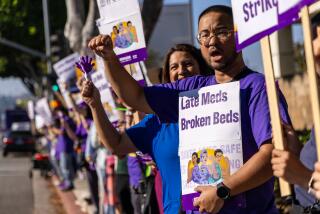California and the West : Hospitals Plan Drill for New Year’s : Medicine: A test run set for Sept. 16 will check for potential problems at facilities across California.
- Share via
Public health officials around California have more than balloons and bubbly on their minds when they consider New Year’s Eve: They worry about power failures, computer crashes--and a potential horde of revelers hurt while celebrating the millennium.
Hospitals are always ready for a surge in emergency room traffic on New Year’s Eve. But they are not sure what to expect when the prospect of millennium partying is layered on top of potential snafus in communications and hospital systems because of Y2K computer trouble.
In a test of readiness unprecedented in scope, California will hold a statewide Y2K drill for hospitals and the emergency medical system Sept. 16 to uncover problems that could surface when the year turns over.
“We are reasonably confident but wary about what the new year means for emergency services,” said Dr. Bruce Haynes, director for emergency medical services for the Orange County Health Care Agency. “Part of the unknowable is the extent that we will be surprised by large numbers of people doing things they otherwise wouldn’t do . . . with the potential for large numbers of injuries.”
The drill will provide information applicable to a wide range of emergencies, said public and health officials.
“Even with earthquakes and fires and riots, this is the first time we have ever done anything statewide like this,” said Gary Symons, safety manager for Kaiser Permanente in Orange County.
More than 350 of California’s 500 acute care hospitals are signed on, said Shirley Tsagris, spokeswoman for the state Emergency Medical Services Authority.
State and local officials are also pressing all ambulance services to join the Y2K drill, which will simulate events possible on Dec. 31, including rolling electricity brownouts, telephone and generator failures, rowdy crowds celebrating at venues from the Rose Bowl to Lake Tahoe, heavy storms from an Alaskan cold front, and a stream of injured people showing up at hospitals.
The drill, which is being coordinated by the Emergency Medical Services Authority and a statewide hospital trade group, is designed primarily to test the emergency medical communications network and its backup systems, as well as how hospitals would handle a flood of problems and assist each other in extreme circumstances.
In particular, officials in Los Angeles and Orange counties want to see how the emergency radio network that links all hospitals and ambulance services will function. The network allows emergency personnel to assess loads at hospitals and emergency rooms and distribute new patients appropriately, Haynes said.
The test also will provide state officials for the first time with a bed availability count statewide that can be used for patient allocation in case of earthquakes, severe flu outbreaks and other disasters, Tsagris said. Although hospitals are licensed according to the number of beds they have, state health officials said, the number of beds that are staffed and available at each hospital changes from day to day.
“We are excited that we will have a system in place that can be used in future emergencies . . . so we will know where we can send patients,” she said.
Most hospitals have devoted considerable resources to checking and updating equipment ranging from patient monitors to expensive diagnostic devices.
“We are pretty confident in our compliance status,” said Caroline Carter, director of communications for the 14-hospital St. Joseph Health Care System. “The statewide drill is not mandatory but all of ours are taking part, and we will have additional practice drills on a regional basis.”
One bug in the Y2K preparations is that hospitals will not report to the state what plans they are making to ensure that patient care will not be disrupted on New Year’s Day.
Hospitals resisted the idea because of potential exposure to lawsuits, said hospital officials. Follow-up reports on the drill, which ask individual hospitals to assess their own readiness, will be filed anonymously with the California Healthcare Assn. and then forwarded to local and state emergency agencies, said Lauri Aldrete, senior vice president of marketing and communications for the trade group.
“The purpose is not to identify specific hospitals with specific issues but [to] determine statewide on an aggregate basis how hospitals are progressing,” she said. “We are confident we are doing very well and do not expect any major problems.”
California officials also expect to benefit on New Year’s from being three hours behind New York and nearly 18 hours behind Australia, in effect having an early warning system.
“The drill will help give us more information about any weak spots in our planning,” Haynes said. “The big unknown is the volume factor. There is a lot of belief that there will be these large parties, but I don’t think anyone knows for sure.”
More to Read
Sign up for Essential California
The most important California stories and recommendations in your inbox every morning.
You may occasionally receive promotional content from the Los Angeles Times.










